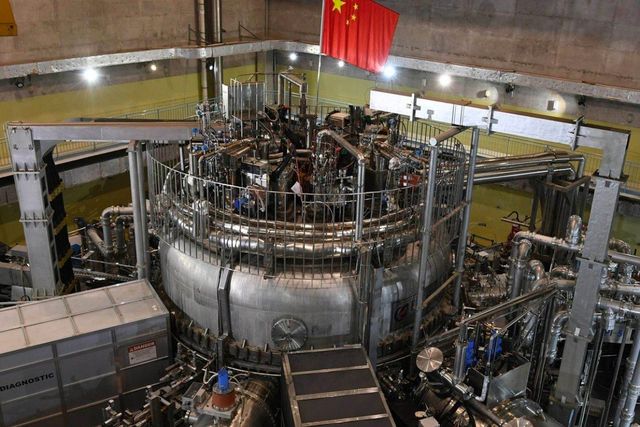China successfully launched ‘artificial sun’, which is 10 times hotter than the core of the sun
- Tram Ho
According to the South China Morning Post, China achieved a new step in creating ‘artificial sun’ after successfully running a new generation HL-2M Tokamak fusion reactor on December 4.
It is known that the HL-2M Tokamak fusion reactor is currently China’s largest and most advanced nuclear fusion research and experiment equipment. Located in southwestern Sichuan province and completed late last year, this reactor is often referred to as an “artificial sun” due to the enormous heat and energy it generates.

The HL-2M Tokamak reactor
According to information published by the National Atomic Corporation of China (CNNC), the HL-2M Tokamak furnace can operate at a temperature of 150 million degrees Celsius – 10 times hotter than the temperature at the core of the Sun. 3 times hotter than the previous version of the HL-2M Tokamak.
“HL-2M is the biggest ‘artificial sun’, with the best Chinese parameters,” said Xu Min, director of the Institute of Thermonuclear Science at CNNC.
The above project is part of China’s involvement with the International Thermonuclear Experimental Reactor (ITER) “Super Project” under construction in the South of France. The ITER project is worth about 24 billion USD, has 35 countries participating and is expected to be completed by 2025. Assembled from 1 million large components and about 10 million small components, ITER furnaces with diameter and dimension. about 30.5 m high. With a weight of 25,000 tons, it is also the largest fusion reactor in the world, capable of generating hot plasma up to 150 million degrees Celsius.
For China alone, the country’s scientists have been researching and developing smaller versions of the ITER fusion reactor since 2006. The HL-2M Tokamak is one of these.

The tomography model of the world’s largest fusion reactor ITER
Basically, reactors like the HL-2M Tokamak and ITER work on the principle of fusion, when two light nuclei of hydrogen, deuterium and tritium, are combined to form a heavier helium nucleus and release it. energy.
This is also the main process that makes up the power of stars like the Sun. In other words, the goal of building a fusion reactor could be compared to “creating an artificial Sun on Earth and plugging it into it to use it,” according to expert Jonathan Menard, currently working at Princeton Plasma Physics Laboratory.
However, for fusion to take place, very high temperatures, up to 120 million degrees C or more, are required. At this temperature, all matter exists in the plasma state.
This is also the basic construction goal of reactors such as ITER and HL-2M Tokamak, to create a mixture of plasma with temperatures up to 150 million degrees Celsius. To create this super-hot temperature, the furnaces the reaction uses hydrogen gas and deuterium (as the fuel to simulate nuclear fusion) by injecting them into a Tokamak-type toroidal magnetic field chamber, which installs electromagnets capable of generating folding magnetic fields 100,000 times the Earth’s magnetic field.

Inside the Tokamak furnace, before and after the start of the process of creating a fusion reaction to form a hot plasma stream of 150 million degrees Celsius.
Finally, the fuel in Tokamak chamber is heated to over 150 million degrees Celsius, forming an extremely hot plasma stream. The ultra-hot plasma flow itself swirls in a circle, “confined” and shaped by a layer of extremely strong magnetic fields. This magnetic structure keeps the hottest parts of the plasma away from the Tokamak walls, creating an insulating effect that allows the furnace to reach very high temperatures.
synthetic
Source : Genk
